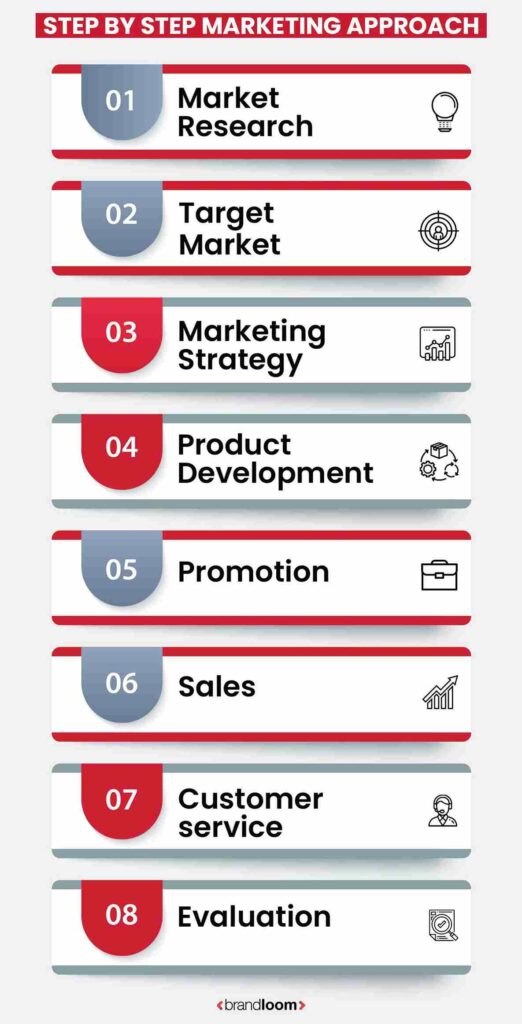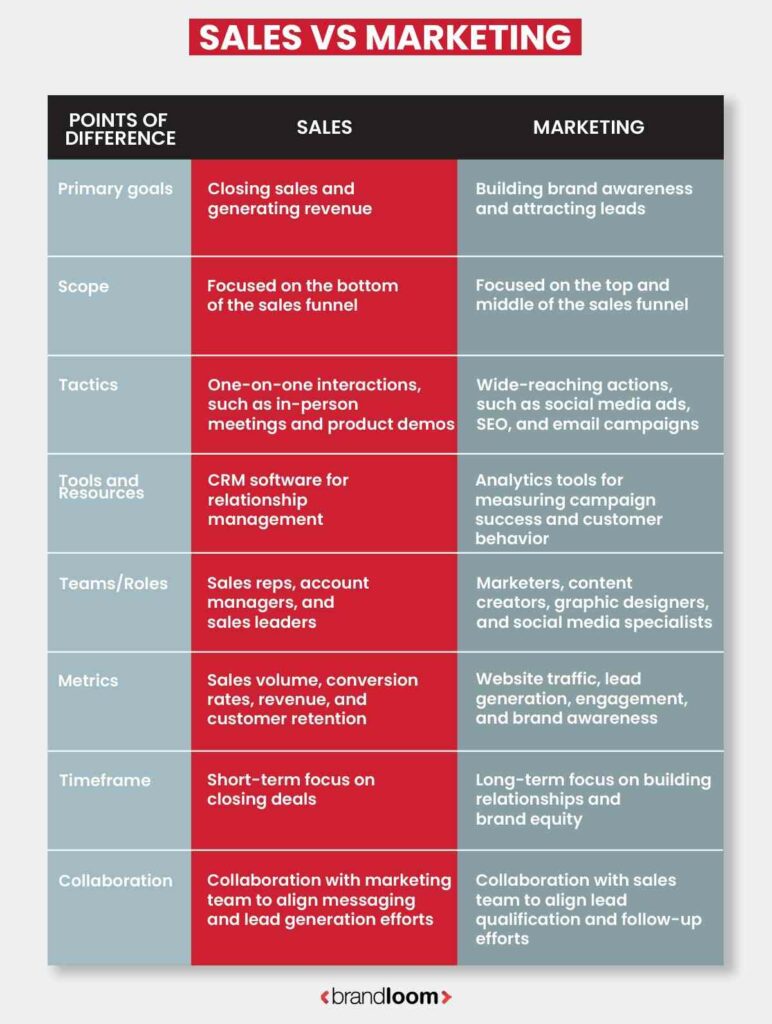Did you know that over 50% of small businesses fail within their first five years? One major reason is that they fail to understand the difference between sales and marketing.
Sales and marketing are often used interchangeably, but they are different. Even though they help a business make money, they take different approaches. Sales focus on closing deals and generating revenue, while marketing creates awareness and interest in a product or service.
If you struggle to build your own sales and marketing team, BrandLoom can help you with sales and marketing campaigns for better reach.
In this blog post, we will explore the difference between sales and marketing, its objectives, roles in a business, tools and techniques used, and provide real-life examples. You should start paying attention if you want to grow your business and your profits.
What is Marketing?
Marketing aims to establish a solid reputation and brand among consumers that distinguish a company from rivals. Increased customer loyalty, brand awareness, and revenue growth are all outcomes of effective marketing.
Advertising, public relations, content marketing, social media marketing, email marketing, search engine optimization (SEO), events, and sponsorships are examples of both inbound and outbound activities that fall under the marketing umbrella.
By developing and delivering valuable and pertinent content and experiences that speak to their needs and interests, marketers hope to draw in, engage, and keep their target audience.
Once you have a thorough idea of the sales and marketing process, you can examine the difference between sales and marketing.
Process of Marketing
The process of marketing involves a series of steps businesses take to promote and sell their products or services to customers.
While the exact process may vary depending on the business, industry, and target audience, the
following are the general steps involved in the marketing process:

1. Market Research
The first step in the marketing process is to conduct market research and analysis to understand customer needs, preferences, behaviors, competition, and market trends.
2. Target Market
Based on market research, businesses can identify their target market or ideal customer, which includes demographics, psychographics, and buying behaviors.
3. Marketing Strategy
Once the target market is defined, businesses can create a marketing strategy that outlines the messaging, positioning, and channels to reach customers.
4. Product Development
To meet the needs and preferences of the target market, businesses may need to develop new products or modify existing ones.
5. Promotion
Promotion involves communicating the product or service’s value to the target market through various channels such as advertising, public relations, content marketing, social media, email marketing, search engine optimization (SEO), events, and sponsorships.
6. Sales
Once customers know the product or service, the sales team can engage with them and close deals.
7. Customer service
Providing excellent customer service is crucial to retaining customers and creating brand loyalty.
8. Evaluation
Finally, businesses should evaluate the effectiveness of their marketing efforts through metrics such as sales, customer satisfaction, and return on investment (ROI) and make adjustments as necessary.
What is Sales?
Sales sell companies’ products or services through various activities, techniques, and channels. It is a critical function of any business that requires a deep understanding of customer needs and behavior and strong communication and negotiation skills.
Sales involve various activities, including identifying potential customers, prospecting, making initial contact, presenting products or services, addressing customer objections, closing the deal, and providing after-sales support.
Salespeople often use various techniques, such as building rapport, identifying customer needs, and emphasizing product benefits, to influence customer behavior and achieve sales goals.
The sales process can vary depending on the nature of the product or service, the target market, and the sales channel. For example, B2B sales may involve longer sales cycles and more complex negotiations, while B2C sales may focus on creating emotional connections with customers to drive impulse purchases.
Process of Sales
The sales process involves a series of steps salespeople take to sell products or services to customers. While the exact process may vary depending on the business, industry, and sales channel, the following are the general steps involved in the sales process:
1 Prospecting:
The first step in the sales process is identifying potential customers interested in the product or service. This can involve various methods, such as cold calling, networking, referrals, and social media.
2 Qualifying:
Once potential customers are identified, salespeople must determine whether they fit the product or service well. This involves asking questions and gathering information about their needs, budget, timeline, and decision-making process.
3 Needs Assessment:
Once a potential customer is qualified, salespeople must understand their needs and pain points. This involves asking open-ended questions and actively listening to their responses to determine if the product or service can solve their problem or meet their needs.
4 Presenting:
After understanding the customer’s needs, salespeople can present the product or service as a solution. This involves highlighting the benefits and features of the product or service and showing how it can address the customer’s specific needs and pain points.
5 Overcoming Objections:
Customers may have objections or concerns about the product or service, such as pricing, features, or competitors. Salespeople must address these objections and provide relevant information to alleviate their concerns and persuade them to purchase.
6 Closing the Sale:
Salespeople can ask for the sale and close the deal once objections are overcome. This can involve various techniques, such as asking for the order, offering incentives, or creating a sense of urgency.
7 Follow-up and Support:
After the sale, salespeople must provide after-sales support to ensure customer satisfaction and encourage repeat business. This can involve following up with the customer, providing training or resources, and addressing any issues or concerns.
What is the difference between sales and marketing?
While sales and marketing are related disciplines, they have different goals and objectives. Let us look closer to understanding the difference between sales and marketing.
| Points of Difference | Sales | Marketing |
| Primary goal | Closing sales and generating revenue | Building brand awareness and attracting leads |
| Scope | Focused on the bottom of the sales funnel | Focused on the top and middle of the sales funnel |
| Tactics | One-on-one interactions, such as in-person meetings and product demos | Wide-reaching actions, such as social media ads, SEO, and email campaigns |
| Tools and Resources | CRM software for relationship management | Analytics tools for measuring campaign success and customer behavior |
| Teams/Roles | Sales reps, account managers, and sales leaders | Marketers, content creators, graphic designers, and social media specialists |
| Metrics | Sales volume, conversion rates, revenue, and customer retention | Website traffic, lead generation, engagement, and brand awareness |
| Timeframe | Short-term focus on closing deals | Long-term focus on building relationships and brand equity |
| Collaboration | Collaboration with the marketing team to align messaging and lead-generation efforts | Collaboration with the sales team to align lead qualification and follow-up efforts |
The difference between sales and marketing Processes
The marketing process involves identifying and understanding customer needs and creating strategies to build awareness, generate interest, and attract potential customers to the business. The process requires market research, segmentation, targeting, positioning, and developing a marketing mix that includes product, price, promotion, and place. The goal is to create a brand that customers recognize and trust, build relationships with potential customers, and generate leads for the sales team.
The sales process involves:
- Identifying and qualifying potential customers.
- Building relationships.
- Presenting the product or service.
- Addressing objections.
- Negotiating.
- Closing the sale.
- Providing ongoing customer support.
- The goal is to convert leads into paying customers, increase revenue, and build long-term customer relationships.

The difference between sales and marketing goals
The primary goal of marketing is to build brand awareness, generate interest, and attract potential customers to the business. Marketing aims to create a favorable image of the brand and build a relationship with the target audience.
The primary goal of sales is to convert leads into paying customers, increase revenue, and build long-term relationships with customers. Sales aim to convince potential customers that the product or service is the best solution for their needs.
The difference between sales and marketing tools and resources
So what is the difference between sales management and marketing management? There are different tools that we use to do sales and marketing. Marketing tools include market research, customer surveys, social media, email marketing, content marketing, SEO, advertising, and public relations. Resources for marketing include marketing automation software, CRM, analytics tools, and budgets for advertising and promotional activities.
Sales tools include customer relationship management (CRM), sales enablement tools, sales training and development, sales analytics, and sales forecasting. Resources for sales include a sales team, a budget for incentives and promotions, and marketing collateral to support sales efforts.
The difference between sales and marketing strategies
Marketing strategies include content marketing, social media marketing, email marketing, search engine marketing, influencer marketing, and event marketing. These strategies aim to build brand awareness, generate leads, and create engagement with potential customers.
Sales strategies include prospecting, qualifying leads, making sales calls, conducting product demonstrations, negotiating deals, and providing after-sales support. These strategies aim to close deals and increase revenue.
The difference between sales and marketing scope
Marketing is focused on building brand awareness, generating leads, and engaging with potential customers. It concerns the entire customer journey, from initial awareness to post-purchase.
Sales are focused on converting leads into paying customers and increasing revenue. It is primarily concerned with the middle and bottom of the sales funnel, where potential customers are close to purchasing.
The difference between sales and marketing tactics
Marketing tactics include:
- Creating content.
- Developing social media campaigns.
- Optimizing a website and blog content.
- Hosting webinars and events.
- Advertising on various channels.
Sales tactics include making phone calls, sending emails, conducting product demos, offering discounts, negotiating deals, and providing customer support.
The difference between sales and marketing teams
Marketing teams typically include roles such as marketing managers, content creators, social media managers, graphic designers, and SEO specialists. The marketing team works to build awareness, generate leads, and create engagement with potential customers.
Sales teams typically include roles such as sales managers, account executives, sales representatives, and customer service representatives. The sales team works to convert leads into paying customers, increase revenue, and provide ongoing customer support.
The difference between sales and marketing prospects
Sales prospects are individuals or companies already interested in a product or service. Sales teams may use various methods to identify prospects, such as lead lists, referral programs, or outreach campaigns. Once identified, sales teams will engage with these prospects to learn more about their needs and offer a product or service that meets them.
Marketing prospects are often individuals or companies that are not yet familiar with a business or its products or services. The teams will use various methods to attract and engage these prospects, such as content marketing, social media, or advertising. Campaigns may be designed to educate prospects about the business or its products, build brand awareness, or create a sense of trust and authority.
Tips for Startups to Differentiate and Implement Sales and Marketing Strategies Effectively
Now that you know the difference between sales and marketing, here are some tips for startups to implement.
Sales Tips
- Define your ideal customer: Identify your target audience, understand their needs and pain points, and tailor your sales pitch accordingly.
- Build a strong sales team: Hire the right people with a strong sales background, and provide them with the necessary training, resources, and tools to succeed.
- Focus on relationship-building: Sales is about closing deals and building long-term customer relationships. Ensure your team focuses on providing value and building trust with prospects.
Marketing Tips
- Develop a brand message: Your message should be clear, concise, and consistent across all marketing channels. Ensure your target audience understands your brand and how you can help them.
- Leverage digital marketing channels: In today’s digital age, it’s important to have a strong online presence. Use social media, email marketing, content marketing, and other digital channels to reach your target audience and build brand awareness.
- Measure your marketing efforts: Use analytics and other tools to measure the effectiveness of your marketing campaigns. This will help you make data-driven decisions and optimize your marketing strategies over time.
Common Tips
Sales and marketing teams need to work together to achieve common goals. Encourage collaboration and communication between the two teams to ensure a unified customer acquisition and retention approach. The sales and marketing landscape is constantly evolving.
Stay up-to-date on the latest trends and best practices, and be willing to experiment and adapt your strategies as needed. Both sales and marketing ultimately revolve around understanding and meeting the needs of your target audience. Keep the customer at the center of your sales and marketing strategies, and aim to provide value and build long-term relationships with them.
What is the difference between sales and marketing, with examples?
Sales and marketing are two related but distinct processes businesses use to promote their products or services and acquire customers.
Let’s consider a company called XYZ that sells high-end athletic shoes. Now let us have a detailed analysis of how marketing differs from sales.
Process
Marketing: XYZ uses a multi-channel approach to reach potential customers. They advertise on social media platforms, sponsor events and athletes, and have an e-commerce website that showcases their products.
Sales: Once a customer shows interest in a product, the sales team engages with them through phone, email, or chat. They answer customer queries and guide them through the purchasing process.
Goals
Marketing: XYZ aims to create awareness and interest in its brand and products. They aim to reach as many potential customers as possible and generate leads.
Sales: The sales team aims to convert leads into paying customers. They aim to close as many deals as possible to increase revenue.
Tools and Resources
Marketing: XYZ uses various marketing tools such as social media management software, SEO tools, marketing automation software, and customer engagement software to optimize its marketing efforts.
Sales: The sales team uses a customer relationship management (CRM) system to manage leads, customer information, and sales activities.
Marketing Tools
XYZ uses various marketing tools to reach potential customers, such as social media platforms (Instagram, Facebook, Twitter), sponsored events, influencer marketing, email marketing, and SEO. They also have a well-designed e-commerce website with high-quality images and product descriptions.
Strategies
Marketing: XYZ’s strategy focuses on creating a solid brand image and identity through sponsorships, partnerships, and collaborations. They target their ads towards a younger demographic that values quality and style in athletic shoes.
Sales: The sales team’s strategy involves a personalized approach to engaging with potential customers. They use a consultative approach, asking questions to understand the customer’s needs and preferences and recommending products accordingly.
Scope
Marketing: The marketing team focuses on creating awareness and generating leads in the upper part of the sales funnel.
Sales: The sales team guides customers through the sales funnel, from consideration to purchase.
Tactics
Marketing: The marketing team uses influencer marketing, email marketing, social media advertising, and sponsored events to reach potential customers.
Sales: The sales team uses personalized outreach, product demos, and consultations to close deals with potential customers.
Teams/Roles
Marketing: The marketing team includes roles such as social media managers, graphic designers, content creators, and digital marketing specialists.
Sales: The sales team includes roles such as account executives, sales representatives, and customer success managers.
The key difference between sales and marketing for XYZ is that marketing focuses on creating awareness and generating leads, while sales focus on converting those leads into paying customers.
Marketing employs a variety of tactics and tools to reach potential customers, while sales use personalized outreach and consultation to close deals. Both departments work together towards the goal of increasing revenue for the company.
Team BrandLoom recommends that startups and entrepreneurs understand the difference between sales and marketing before running campaigns. Although sales and marketing are closely related, they serve different functions in the business.
Conclusion
Sales and marketing are two essential functions critical to any business’s success. With the support of a specialized digital marketing agency like Brandloom, companies can effectively align their sales and marketing efforts to achieve their business goals.
Sales focus on closing deals and generating revenue, while marketing focuses on building brand awareness, educating prospects, and creating demand for products or services.
Understanding how the marketing concept differs from the sales concept and how they impact your business is crucial for developing effective strategies to drive growth and achieve your business goals.
By aligning their sales and marketing efforts and working together towards a common objective, businesses can create a seamless customer journey and deliver a superior experience that can drive customer loyalty and growth in the long term.
Frequently Asked Questions
Sales and marketing are fundamentally different because sales concentrate on closing deals and generating revenue.
In contrast, marketing aims to increase customer awareness of the brand, inform prospects, and generate demand for goods and services.
To convince prospects or customers to purchase, salespeople must interact directly with them, frequently through one-on-one conversations or presentations.
However, marketing entails a broader range of activities to reach a larger audience and create a brand that appeals to potential customers. These activities include market research, advertising, content creation, and social media management.
Sales and marketing have different objectives in several ways. Deals must be closed for sales to produce revenue for the company.
The sales team is frequently evaluated on their capacity to reach revenue goals and close deals within predetermined deadlines.
However, marketing aims to increase brand recognition, generate demand, and inform potential customers about the company’s goods or services.
The marketing team’s performance is frequently judged on its capacity to boost website traffic, produce leads, and enhance brand recognition.
Although both sales and marketing ultimately help to increase revenue, each function has its own goals that must be met using various strategies and tactics.
A strong sales team is critical for generating revenue and closing deals. On the other hand, a solid marketing strategy is essential to increase brand recognition, draw in potential customers, and generate demand for goods or services. A company might struggle to expand and meet its objectives without these essential operations.
There might be a few exceptions, such as companies offering a particular good or service with high market demand or those operating in a specialized market with few rivals. However, even in these situations, it’s crucial to have at least a few fundamental sales and marketing techniques to ensure the company keeps bringing in and retaining customers.
It isn’t ideal for most businesses, even though it is theoretically possible for a company to have a successful sales strategy without a marketing strategy or vice versa. This is due to the crucial and complementary roles that sales and marketing play in generating revenue and expanding a business. If you are looking for a good sales strategy, BrandLoom can guide you through.
An effective marketing plan can help generate demand for a company’s goods or services, increase brand recognition, and draw in new clients. Due to potential customers’ possible familiarity with the company and its products, this can facilitate the sales process. On the other hand, a successful sales strategy can aid in closing deals and bringing in money. Still, without a solid marketing plan, a company may struggle to draw in new clients or sustainably develop its brand.
The customer journey differs between sales and marketing in several ways. Marketing generally focuses on the early stages of the customer journey, such as building awareness, generating interest, and educating potential customers about the business’s products or services. Marketing aims to attract potential customers and educate them on the company’s benefits.
A potential customer may proceed to the sales process, which is typically concentrated on the later stages of the customer journey, once they know the company and its offerings. The sales team converts prospects into paying customers by attending to their needs, alleviating potential customers’ concerns, and ultimately closing the deal.
Marketing strategies used in the customer journey include advertising, content, social media, and email marketing. In contrast, the customer journey in sales typically entails more direct and personalized interactions with potential customers through meetings, phone calls, and product demonstrations. If you do not want to get into the complications, BrandLoom can guide you through the entire process.
Sales teams use a variety of tactics to identify and engage with prospects. Some of the most common methods include:
Research: Sales teams often research to identify potential customers who may fit their products or services well. This can involve searching for companies or individuals who match specific criteria, such as size, industry, or location.
Networking: Sales teams may attend networking events or conferences to meet potential customers and build relationships.
Cold calling: This involves reaching out to potential customers via phone to introduce the business and its offerings and to see if there is interest in learning more.
Email outreach: Sales teams may also email potential customers, using targeted messaging and personalized content to build interest and engagement.
Social media: Sales teams may use social media platforms like LinkedIn to identify and engage with potential customers.
Once a sales team has identified potential prospects, they typically engage with them through various methods, such as phone calls, email outreach, or in-person meetings. The purpose of these interactions is to establish rapport, comprehend the needs and difficulties of the prospect, and ultimately move them toward making a purchase.







